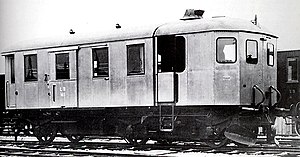LB M 1
| LB M 1 | |
|---|---|
|
Steam railcar of the LB
|
|
| Numbering: | LB M 1 |
| Number: | 1 |
| Manufacturer: |
Aktiebolaget Arlöfs Mekaniska Verkstad & Waggonfabrik , Arlöv , Sweden |
| Year of construction (s): | 1911 |
| Retirement: | Remodeling in 1916 |
| Axis formula : | (1A) '1 |
| Gauge : | 1435 mm ( standard gauge ) |
| Length over buffers: | 11,100 mm |
| Height: | 3,730 mm |
| Width: | 3,000 mm |
| Bogie axle base: | 3,000 mm |
| Payload: | 5 t |
| Service mass: | 40.0 t |
| Friction mass: | 27.0 t |
| Top speed: | 45 km / h |
| Continuous output : | 150 hp at 550 min -1 |
| Driving wheel diameter: | 940 mm |
| Wheel diameter: | 940 mm |
| Number of cylinders: | 2 |
| HD cylinder diameter: | 200 mm |
| LP cylinder diameter: | 140 mm |
| Piston stroke: | 200 mm |
| Boiler overpressure: | 24 kg / cm² |
| Grate area: | 0.5 m² |
| Operating mode: | steam |
| Seats: | 30th |
| Loading area: | 14.5 m² |
Langelandsbanen (LB), a Danish private railway on Langeland , procured three LB 1-3 tank locomotives and the LB M 1 steam powered railcar on the Rudkøbing – Bagenkop and Skrøbelev – Spodsbjerg lines that opened in 1911 .
history
The railcar was built with the serial number 8 by Aktiebolaget Arlöfs Mekaniska Verkstad & Waggonfabrik in Arlöv in Sweden and somewhat misleadingly referred to as Denmark's first motor car ( Danish: Danmarks første motorvogn ). The purchase price was 26,945 crowns . The car came to Rudkøbing on July 5, 1911 with the steam ferry Marie together with five seated cars .
Technical facility
The steam boiler, designed and manufactured by the French company Purrey in Bordeaux , as well as the engine, as well as the water and coal supply, were housed in the machine part on one side of the vehicle. Under the machine part, the vehicle had a bogie , while the other end rested on a single axle. All three axles had wheelset bearings with roller bearings .
The water tube boiler with superheater had the unusually high steam pressure of 24 kg / cm². Two two-cylinder compound steam engines, each with one high-pressure and one low-pressure cylinder, provided the drive. The machines drove the front axle under the machine part with a chain transmission via a jackshaft . The feed water for the boiler was supplied with a high-pressure pump regulated with a float, the coal supply was carried out with a mechanical shaking grate.
The three-meter-wide and about ten-meter-long box body had a large driver's and engine room above the machine bogie , while on the other side of the car there was a small room for the driver and a battery room. In the approximately five meter long passenger compartment there was space for either 30 wooden seats for the passengers or for five tons of cargo. In addition to the narrow swing doors at both ends of the passenger compartment, access was possible through two large sliding doors on the sides. At the rear end of the car there was a closed platform with side doors and a central door to a transition bridge. The car could only run with the engine end ahead and had to be turned at the end stations.
The railcar could be operated and driven by one person and was able to pull a trailer load of 35 tons.
Conversions
From the beginning there were problems with the boiler and machine and especially with the feed water pump, because it was difficult to maintain the relatively high steam pressure.
The railcar was therefore decommissioned in September 1914, and the company was forced to purchase a normal 1 'B steam locomotive from Nydqvist och Holm with the number LB 4 as a replacement. The then parked steam railcar was retired in 1916 after only 42,264 kilometers. In the last year of operation it had only covered 2,464 kilometers.
The car was not scrapped, however, but converted into a baggage car in 1918 in the company's own workshop , which was given the number LB E 43 . The 8.37 m long and 9.7 ton car received a screw brake. In 1933 there was another conversion to a freight car . The vehicle that was used on the Nyborg –ringen – Faaborg Banen on the island of Fyn was given the number LB IC 254 . In 1954 the car was scrapped in Rudkøbing.
Individual evidence
- ↑ Danmarks første motorvogn . (No longer available online.) In: toptop.dk. Archived from the original on April 12, 2013 ; Retrieved December 26, 2017 (Danish).
Web links
- Description of the LB M1. In: jernbanen.dk. Retrieved December 27, 2017 (Danish).
- Vehicle drawing. In: jernbanen.dk. Retrieved December 27, 2017 (Danish).
- Photo of the railcar. Retrieved December 27, 2017 (Danish).
- Information about the steam railcar at langelandsbanensvenner.dk. langelandsbanensvenner.dk, accessed December 27, 2017 (Danish).
- Technical specifications. Retrieved December 27, 2017 .
